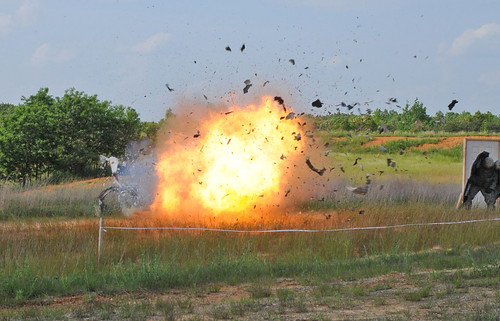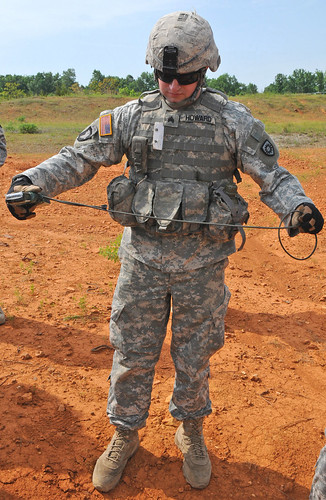Story by Sgt. Brandy Mort, 133rd Mobile Public Affairs Detachment
[caption id="" align="aligncenter" width="619"]
Soldiers of the 577th Sapper Company inspect a mobile door frame before attaching a silhouette charge during demolition training at Fort Knox, Ky., May 15, 2015. A silhouette charge provides a hole in a door so Soldiers can gain access into a building. (U.S. Army National Guard photo by Sgt. Brandy Mort)
FORT KNOX, Ky. – The terrain rumbled as pieces of a wooden door shot out in every direction. From the looks of the scene, you’d think a tornado had ravaged the area. Instead, it was a silhouette charge the
577th Sapper Company had attached during their demolition training.
Soldiers of the 201st Engineer Battalion,
577th Sapper Company, participated in standard demolition training at Fort Knox,
Kentucky, May 15-16.
Capt. James Schmitz,
577th Sapper commander, said Sapper teams are essential for troops to advance through breached obstacles, such as a collapsed building, safely. He said this training helped when they deployed to Afghanistan in 2009.
[caption id="" align="alignleft" width="380"]

Soldiers of the 577th Sapper Company take cover during demolition training at Fort Knox, Ky., May 15-16, 2015. A C-4 charge blast takes 1.34 seconds after detonation. (U.S. Army National Guard photo by Sgt. Brandy Mort)
“Proper demolition training is very essential,” said Schmitz. “It is vital to get it right before we are tasked to do it in the future, whether it’s for our training exercise in Louisiana or a future deployment. We need to do it right, here, so we can do it right, there.”
Sgt. John Howard, Sapper non-commissioned officer, has 10 years experience in the engineers. It’s that experience, he said, that keeps the unit proficient. He said, each year leadership uses lessons learned to improve the training.
“When I was new I got vital training during this time and I use things I have learned through the years as I teach other junior enlisted to do the same,” he said.
Click here for more photos.
Traditionally Sappers are combat engineers who advance with the front-line infantry and are some of the first people sent to assess damages caused. Howard said training the younger Soldiers in their craft is similar to the role of the combat engineer sweeping the battlefield; they make sure the path is safe and clear before others go through.
[caption id="" align="alignright" width="248"]

Sgt. John Howard, combat engineer with the 577th Sapper Company, unravels a C-4 charge during demolition training at Fort Knox, Ky., May 15-16, 2015. This year is Howard’s 10-year anniversary with the Kentucky National Guard’s 577th Sapper Company. (U.S. Army National Guard photo by Sgt. Brandy Mort)
“As a Sapper, we are the first people sent into the building to ensure the foundation is stable,” said Howard. “I use the same method as a platoon sergeant. If I don’t tell them the proper information, they won’t be able to be a strong foundation for their legacy.”
Staff Sgt. Aleksandr Vinogradov, a combat engineer, agrees that good leaders start from the beginning of their career.
“New Soldiers to the unit are like sponges,” said Vinogradov. “They will absorb anything you teach them. It is important to set a good example and train them the correct. We need to train for the future, not for the present.”
The team trained in various types of C-4 charges: A simulation charge, shape charges, Bangalore charges, urban breaching and mine clearing, also known as, MCLC. During urban breaching, they learned about linear door charges and silhouette charges. Sappers use what they learn in these scenarios for reforming the terrain for new structures, or to demolish existing structures.
“During urban breaching, we are able to see that different charges do different things,” said Howard. “A linear door charge will split a door in half, while a silhouette charge will create a hole in the door big enough for a person to walk through. If we don’t use the correct one in a non-training environment, we may be in trouble.”
Schmidtz said that safety and proficiency are two very important topics he focuses on at all times.
“My goal is to have everyone perform proficiently at their tasks and, most importantly, practice proper safety at all times. I have no doubt that my Soldiers will succeed in both aspects, whether in training exercises or in real-world scenarios.”
The Sapper Company is participating in this training in preparation for their annual training at the Joint Readiness Training Center in Fort Polk, Louisiana.